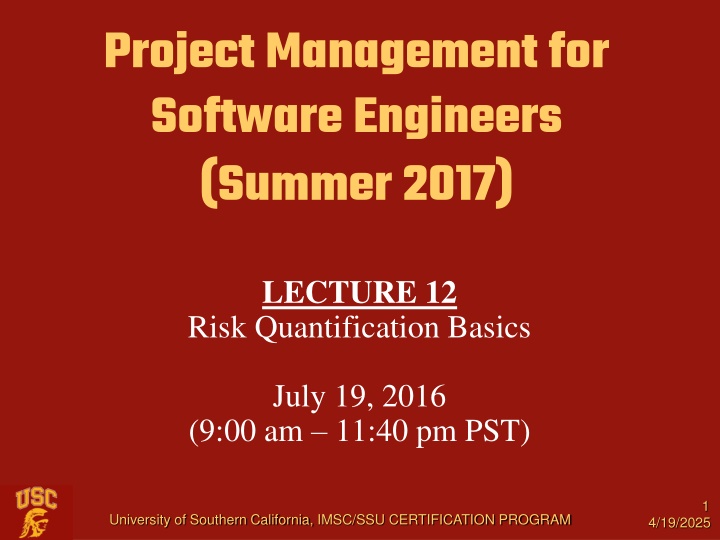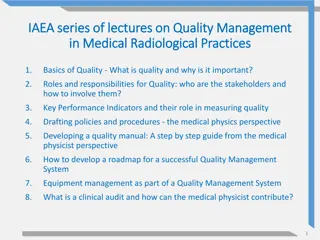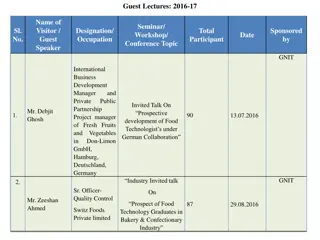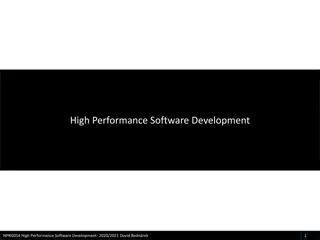
Software Engineering Project Management: Risk Quantification Basics
Dive into the fundamentals of risk quantification in software engineering project management, covering uncertainty, probabilities, statistics, and distributions to enhance decision-making and project outcomes.
Download Presentation

Please find below an Image/Link to download the presentation.
The content on the website is provided AS IS for your information and personal use only. It may not be sold, licensed, or shared on other websites without obtaining consent from the author. If you encounter any issues during the download, it is possible that the publisher has removed the file from their server.
You are allowed to download the files provided on this website for personal or commercial use, subject to the condition that they are used lawfully. All files are the property of their respective owners.
The content on the website is provided AS IS for your information and personal use only. It may not be sold, licensed, or shared on other websites without obtaining consent from the author.
E N D
Presentation Transcript
Project Management for Software Engineers (Summer 2017) LECTURE 12 Risk Quantification Basics July 19, 2016 (9:00 am 11:40 pm PST) 1 University of Southern California, IMSC/SSU CERTIFICATION PROGRAM 4/19/2025
Risk = Uncertainty Risk quantification means: How much uncertain are we about a particular outcome Supplier Input Process Output Customer: Focusing on the I.P.O: If we know how much uncertain we are about the Inputs, we can agglomerate all uncertainties to calculate the uncertainty about the output, using statistical techniques (simulation) 2 University of Southern California, IMSC/SSU CERTIFICATION PROGRAM 4/19/2025
A Crash Course on Probabilities A + Ac = 1 P(A or B) = P(A) + P(B) P (A and B) Mutually Exclusive events: P(A and B) =0 Conditional Probability P(A|B) = P(A and B) / P(B) P(A and B) = P(A|B)xP(B) Joint Probabilities: Decision Tree (pp. 257-258) Independent Events: P(A|B)=P(A) P(A and B) =P(A)xP(B) 3 University of Southern California, IMSC/SSU CERTIFICATION PROGRAM 4/19/2025
A Crash Course on Statistics Descriptive Statistics Current Data attributes (central tendency & dispersion) Histograms: Location, Spread, Shape Inferential Statistics (Enumerative Studies) Sample Population (Hypothesis Testing) Key: Proper Sampling Representative Sample Predictive Statistics (Analytic Studies) DOE, Regression, ANOVA 4 University of Southern California, IMSC/SSU CERTIFICATION PROGRAM 4/19/2025
Descriptive Statistics Central tendency: Mean, median, mode Dispersion: Variance, Min, Max, Range Shape: Histogram, Skewness, Kurtosis Others: Count, Sum Excel Example: Tools Data Analysis Descriptive Statistics Tools Data Analysis Histogram 5 University of Southern California, IMSC/SSU CERTIFICATION PROGRAM 4/19/2025
Statistical Distributions Discrete: Binomial, Hypergeometric, Poisson, Continuous: Normal, Lognormal, Exponential, Interrelationships Binomial Poisson Normal Lognormal Poisson Exponential Sources of abnormality: Recording & Measurement errors, Multiplicity, truncation, natural skewness, tampering (Deming experiments) Understand data & sources of variation before sampling 6 University of Southern California, IMSC/SSU CERTIFICATION PROGRAM 4/19/2025
Inferential Statistics Sampling: Select an unbiased subset of an entire group Simple Random Sampling (SRS): For homogeneous sets Stratified sampling: Group by some attributes (internally homogeneous) Clustering: Similar groups, different components ( Naturally clustered, internally heterogeneous) Less Precise & More Economic Systematic: Every (N/n)th sample, or some other rules (Easy, but prone to bias) Examples: Random, NOT arbitrary! Stratified: Sampling City population, in age groups Stratified: Exponential Distribution Clustered: Sampling random pallets of packed products Systematic: Sampling every 8th house of a street with 120 houses
Representative Samples If the sampling is performed properly, the sample represents the population Parameter Parameter Sample Sample Size Size n Mean Mean x x St. Dev. St. Dev. s s Population Population N N m m s s CLT For very large population (n/N<0.05) and Truly representative samples: E(x x ) = m m & s s(x x )=s s / n x x ~ N ( m m , , s s / n ) Example: P. 280, Examples 6.13 & 6.14 N(x, m m, s s) == Ns[(x-m m)/s s, 0, 1] In CLT: In CLT: x x ~ Ns [(x x --m m) )/ /( (s s / n ),0,1] University of Southern California, Industrial & Systems Engineering Note: Ns Table (pp.A3&A4) 8 4/19/2025
From Point To Range Estimate Confidence Level (CL) = 1 - a a a a = Probability of a parameter falling outside a given range. (e.g. probability of defect) Example: 90% CI for m m is x x + q q means In 100 samples, for 90 of them: the range [x x - q qx x + q q ] contains the true value of m m Equations: P. 281 Examples 6.15 & 6.16 (p. 282) 9 University of Southern California, Industrial & Systems Engineering 4/19/2025
What is simulation? Problem: Flipping a coin as many times as we get 3 heads; Cost: $1 per coin-flip, reward: $8 for 3 heads Can you develop a formula to get the answer? Yes you can, but it s a tedious and complicated process. Can it be done easier? Just walk the talk: Generate a random integer (0, 1) Excel: Int((Rand()+0.5)) Repeat until you get three 1 s (heads) If we repeat this experiment many many times, we can develop a statistical distribution for the sample size (i.e. number of flips that returns 3 heads) Estimating reality by experimentation Example calculations in Excel (handout) 10 University of Southern California, IMSC/SSU CERTIFICATION PROGRAM 4/19/2025
Monte-Carlo Simulation Process: If Y= (X1,X2,X3, ) and statistical distribution of Xi s are known as F(Xi), then: U = F(Xi) Xi = F-1(U), where U is a probability, a random number between 0 and 1 (100%) With numerous iterations, statistical distribution of Y and its statistical characteristics can be modeled and the probability of Y<=Y0 can be estimated with a very high accuracy The more iterations, the more accurate the statistical distribution for Y For each Xi: For the entire model (Y): N=100 N=200 N=500 N=1000 Source: Queueing Methods, Randolph W. Hall (1991), P. 59 11 University of Southern California, IMSC/SSU CERTIFICATION PROGRAM 4/19/2025
A Basic Example A Typical customer service: Poisson Process ? ? = 1 ? l?, SET: R[0 1] = ? ? ? =ln ? l Assume l=4 customers / hour based on historical data How many customers will arrive in 2 hours? Trial #1 Trial #2 Trial #3 Trial #4 Trial #5 n RAND 1 0.184117 2 0.162222 3 0.835792 4 0.795659 5 0.179481 6 0.200616 Arrival Time 0.423045546 0.423046 0.454698087 0.877744 0.044843731 0.922587 0.057146139 0.979734 0.429422115 1.409156 0.401590104 1.810746 Ellapsed Time N=6 N=5 #1 #2 N=2 #3 #4 #5 N=4 N=5 12 University of Southern California, IMSC/SSU CERTIFICATION PROGRAM 4/19/2025
Simulating PM Metrics NPV : pp 310-318 CPM/PERT Scheduling: pp 367-372 13 University of Southern California, IMSC/SSU CERTIFICATION PROGRAM 4/19/2025






















